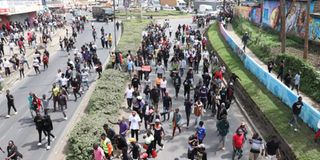How repeated injustice has turned quiet Nakuru into a hotbed of fiery protests

A protester walks past a bonfire lit along Nakuru-Kabarak road during protests on June 10,2025.
For years, Nakuru has carried the tag of a quiet town.
People have always minded their business, conflicts rarely spilled onto the streets, and grievances were handled away from the public eye.
But something has shifted.
Today, residents are increasingly turning to the streets to air their frustrations, something that was almost unheard of just a few years ago.
Since the 2023 cost-of-living protests that swept across the country, Nakuru has witnessed a string of protests on both local and national issues. Each protest seems to fuel the next, turning public demonstrations into a default response whenever conflict arises.
The following year we had the Gen Z-led anti-Finance Bill protests that saw tear gas thrown, arrests being made, and four deaths recorded.

Youth in Nakuru march along the Nakuru-Nairobi highway during the anti-finance bill demos on June 20, 2024.
In that same June 2024, students from the Rift Valley National polytechnic took to the streets in protest at what they said was a lack of proper facilities at the school.
Later in 2024, we had the anti-femicide protest following several murders of women in the county.
This year alone, we’ve had more than five protests only six months in.
We started with the disappearance of Brian Odhiambo which triggered a seven-day protest that paralyzed parts of the town and residential estates.
In the same month we also had a protest in Molo over the death of Molo president, Richard Otieno.
Before the dust settled, we had a protest by the deaf community demanding finding baby Mercy Chepng’eno’s body that mysteriously disappeared at the Nakuru PGH morgue.

Mercy Chepng'eno's mother crying during protests over the mysterious disappearance of Baby Mercy's body at the Nakuru PGH Morgue. Photo taken on February 17, 2025.
Medical professionals at one point staged a protest lamenting poor working conditions and salary delays and demanding their absorption as permanent and pensionable staff.
Pipeline residents in May staged their demonstrations, highlighting the increased level of insecurity that led to the death of a businessman in the area.
This was followed by street children who took to the streets this month, in protest of alleged mistreatment by a vigilante group within the market and matatu stages.
And just this week, we’ve had a two-day protest following the fatal shooting of a middle-aged man in London estate by the police in an alleged bribery case.
Perhaps the pattern that can be deduced is that residents in Nakuru are tired of being silent and have grown bolder in their demands to be heard. Perhaps even, in many cases, these grievances have remained trapped on these social platforms, never reaching the attention of authorities or security agencies.
When these online complaints fail to trigger action, residents often feel compelled to take to the streets, believing that public demonstrations are the only way to force a response.
Calvin Muga, a programs officer at Midrift Hurinet, says the right to demonstrate has not been suspended, and young people are increasingly using it as an outlet to express their frustrations.
However, he warns that unless all stakeholders are brought together for meaningful dialogue, the situation may escalate further.
“If we do not bridge the current gap, we are going to face bigger problems in the future,” he said during the June 10 X Space discussion.
He noted that the tensions come at a time when the country is still awaiting the 2025 Finance Bill, economic pressures continue to mount, and a general election looms just two years away- all factors that could further fuel public discontent if not carefully managed.


